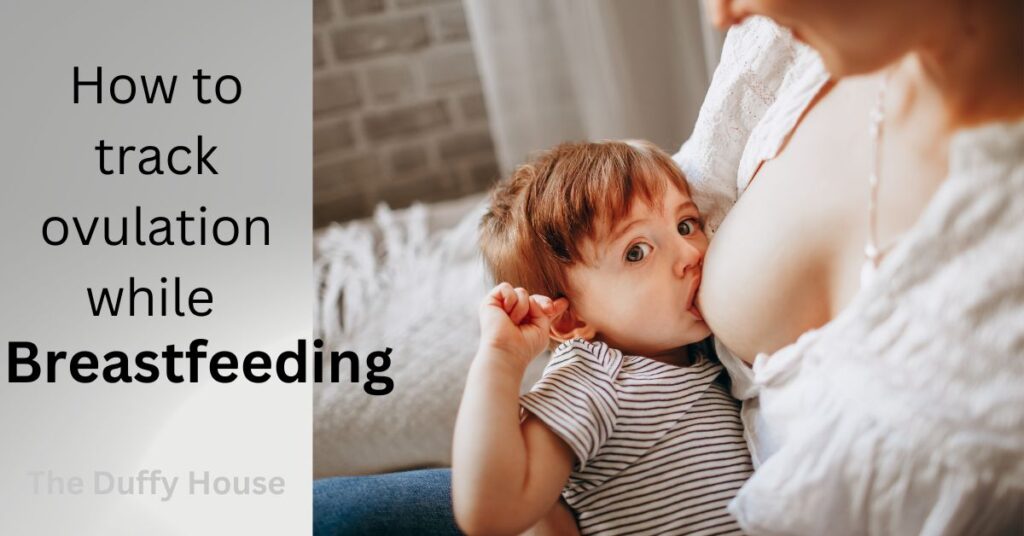
Introduction
Tracking ovulation while breastfeeding can be challenging due to hormonal changes and irregular menstrual cycles. In this article, we’ll provide a comprehensive guide to help you understand how to track ovulation while breastfeeding. Understanding the impact of breastfeeding on ovulation, exploring different tracking methods, considering factors that affect fertility, and seeking professional guidance are key to achieving your reproductive health goals.
How to Track Ovulation While Breastfeeding?
We need to understand some essential matrices related to this topic to track ovulation while breastfeeding.
Understanding the Impact of Breastfeeding on Ovulation and Fertility
Breastfeeding has a natural contraceptive effect called the Lactational Amenorrhea Method (LAM). While it can temporarily suppress ovulation, it’s important to note that LAM is not foolproof, and fertility can return at different times for each individual.
Cervical Mucus Monitoring
Monitoring changes in cervical mucus is useful for tracking ovulation while breastfeeding. The consistency and color of cervical mucus can provide insights into your fertility window. During ovulation, cervical mucus becomes clear, slippery, and stretchy, resembling raw egg whites.
Basal Body Temperature (BBT) Charting
Charting basal body temperature involves tracking your waking body temperature daily. A slight temperature rise indicates ovulation. While breastfeeding may bring some challenges to BBT charting due to disrupted sleep patterns, consistent measurements can reveal a predictable ovulation pattern over time.
Ovulation Predictor Kits (OPKs)
Ovulation Predictor Kits are urine-based tests that detect the luteinizing hormone (LH) presence. As the LH surge precedes ovulation, a positive OPK result suggests ovulation is likely to occur within the next 24-48 hours. OPKs help track ovulation while breastfeeding, especially when used alongside other methods.
Signs and Symptoms of Ovulation
Understanding your body’s signs and symptoms of ovulation can assist in tracking fertility. Mid-cycle pelvic pain, breast tenderness, heightened sense of smell, increased libido, and mood changes are common indicators. Paying attention to these signs provides additional clues about your ovulatory cycle.
The Lactational Amenorrhea Method (LAM)
LAM is a temporary contraceptive method in the early postpartum period, relying on exclusive breastfeeding and the absence of menstruation. Adhering to nursing on-demand, including nighttime feedings, and avoiding supplemental feedings are necessary for LAM to be effective.
Charting Menstrual Cycles
Although breastfeeding can cause irregular menstrual cycles, charting them can still be helpful. By recording the timing and duration of your periods, you can identify patterns and gain insights into your postpartum fertility status. This tracking aids in predicting ovulation and increases the chances of conception if desired.
Breastfeeding Patterns and Their Impact on Ovulation
The frequency and duration of breastfeeding sessions can affect ovulation. More frequent and prolonged feedings tend to suppress ovulation. However, as your baby grows and starts consuming solids, breastfeeding frequency might decrease, potentially leading to the return of ovulation. Staying aware of your breastfeeding patterns is crucial for effective ovulation tracking.
The Weaning Process and Its Impact on Fertility
Weaning, the gradual transition from breastfeeding to other forms of nutrition, affects the return of fertility. As breastfeeding patterns change and sessions reduce, hormonal balances shift, potentially signaling the return of ovulation. Remember that the resumption of fertility varies, so continue contraception until you’re ready for another pregnancy.
Tracking Hormonal Changes
Hormone levels play a significant role in ovulation. While breastfeeding, the hormone prolactin, responsible for milk production, can suppress the release of follicle-stimulating hormone (FSH) and luteinizing hormone (LH). Decreasing prolactin levels signal the rise of FSH and LH, indicating the return of ovulation. Understanding these hormonal changes helps track ovulation effectively.
Factors That May Affect Ovulation During Breastfeeding
Various factors can influence ovulation while breastfeeding, including nutrition, stress levels, and overall health. A balanced diet, stress management techniques, and self-care practices support reproductive health during this phase.
Understanding Fertility Signs
Fertility signs include physical and hormonal changes that indicate fertile or infertile periods. These signs encompass cervical mucus consistency, BBT variations, changes in cervical position, and cervix appearance. Recognizing these fertility signs aids in accurately identifying your most fertile days.
Benefits and Limitations of Tracking Methods
Each tracking method has advantages and limitations. Cervical mucus monitoring is cost-effective but relies on accurate observation. BBT charting is reliable but requires consistent measurements and a steady sleep schedule. OPKs provide a convenient method but can be more costly. Understanding the pros and cons helps you select the most suitable option.
Considering Alternative Birth Control Methods
If pregnancy is not intended, consider alternative birth control methods. While hormonal methods may interfere with breastfeeding, non-hormonal options such as barrier methods, natural family planning, and copper IUDs can be effective. Consult with your healthcare provider to determine the best contraceptive option for you.
Sharing Personal Experiences
Get in touch with mothers who have successfully tracked ovulation while breastfeeding and from their experiences, you can get the right guidance that will teach you how to track ovulation while breastfeeding. Join online communities, forums, or local support groups where you can share experiences and connect with other women who have been through similar situations. Hearing their stories can provide a sense of encouragement and unity.
Seek Professional Guidance
It is crucial to seek professional guidance from a healthcare provider with expertise in reproductive health when tracking ovulation while breastfeeding. They can provide personalized advice based on your unique situation, provide insight into tracking procedures, address specific concerns, and provide support throughout the process.
Conclusion
Tracking ovulation while breastfeeding can be quite a challenge, but it can be accomplished with diligence and proper technique. By combining methods like cervical mucus monitoring, BBT charting, and OPK, you can better understand how to track ovulation while breastfeeding. It is very important to remember that the return of ovulation can vary, so careful monitoring and guidance from a healthcare professional is essential. Embrace your journey with patience and maintain open communication with your healthcare provider to make informed decisions about your reproductive health.
Referrence:
1. World Health Organization (WHO): They provide information on LAM
2. Centers for Disease Control and Prevention (CDC): birth control methods while breastfeeding
